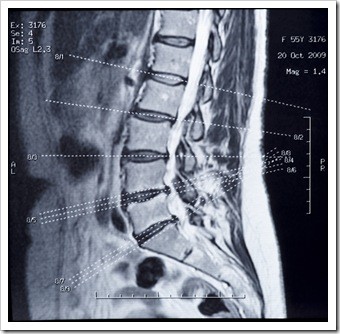
Your sciatic nerve is the longest and widest nerve in your body, and runs from the lower back, down through the buttock, and all the way into the lower leg, where it controls the muscles in that area. It also provides sensation to the thighs, legs, and the soles of the feet. When the sciatic nerve becomes irritated for some reason and causes pain, this pain is known as sciatica. Sciatica refers to the various symptoms associated with the irritation, and does not give any indication as to the root cause of the irritation.
Much of the low-back and leg pain reported is sciatic pain, and it is most evident in the age bracket of 30 to 50 years old. It is more commonly a result of general wear and tear, rather than an injury.
The Symptoms of Sciatic Leg Pain
The most obvious giveaway that you are suffering sciatic pain is when it follows the route of the sciatic nerve, as previously described, and is typically apparent only on one side of the body. However, there are variations in how exactly that pain is felt, including tingling, aching or burning. It depends on where the sciatic nerve is being affected. Some patients may also feel pins-and-needles in the toes or foot, or muscle numbness/weakness in the affected leg or foot
More often than not, sciatica first manifests slowly, then increases in intensity, often being accentuated after sitting or bending, or sudden movements such as sneezing or coughing.
Diagnosing Sciatic Leg Pain
This starts with your doctor of chiropractic taking a complete patient history. Your descriptions of where the pain is, how it is felt, when it began, and which activities cause you most pain, are all important in helping to form a diagnosis. It is also necessary to undergo a physical and neurological examination, with a particular focus on your spine and legs. Your ability to perform certain activities will be monitored to assess your sensory strength, muscle strength, and reflexes, and any pain resulting from these activities.
Diagnostic imaging, such as x-ray, MRI, or CT scan may be ordered by your doctor of chiropractic if it is felt there may be more at play, such as a serious underlying problem. This may happen if there is no improvement in symptoms following 6 to 8 weeks of conservative treatment.
Sciatic Leg Pain Treatment Options
Conservative care, including chiropractic treatment, is a very effective solution for most people suffering sciatic pain. As there is an array of possible causes of sciatica, treatment plans will be individually tailored depending on what your chiropractor finds in your particular case. When we talk about “conservative”, it refers to the absence of surgical procedures or medication. Instead, chiropractic seeks to rectify spinal problems, thus restore spinal movement and reduce the inflammation that’s causing the sciatica. Treatment may include spinal manipulation and adjustments, the application of ice/heat therapy, ultrasound, use of a TENS machine, and rehabilitative exercises.
Prevention Is Better Than Cure
To protect your back, improve your spinal health, and guard as best you can against sciatica developing in the first place, follow these tips:
- Follow a healthy diet
- Maintain a healthy weight
- Exercise regularly
- Practice proper posture
- Avoid too much inactivity or bed rest
- Quit smoking
- Lift things safely, using good body mechanics
For Your Health,
Dr. Scott Van Dam

